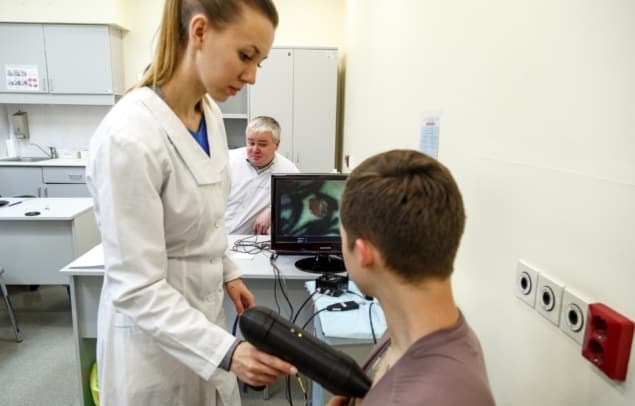Three-in-one approach detects early skin cancers
05 Nov 2018
Researchers in Russia have developed a new method for diagnosing early-stage skin cancers far more efficiently than current techniques allow. Valery Zakharov and his team at Samara University achieved the result by combining readings from three devices that take a wide variety of spectral measurements of patients’ skin. The researchers believe their work will help to increase rates of successful diagnosis and treatment of skin cancers before they progress to dangerous later stages (Proc. SPIE 10.1117/12.2320483).
Skin cancers, including melanoma, can be treatable once diagnosed, but the rates at which clinicians can currently detect their symptoms are worryingly low. “Even high-tech traditional diagnostic methods are not effective enough,” Zakharov tells Physics World. “The probability of detecting oncology with their help is approximately 70%, and with examination by a doctor, it is no higher than 50%.”
The success of skin cancer treatments strongly depends on when their characteristic symptoms are first spotted. While 98% of patients who are diagnosed with early-stage melanoma are now successfully treated, for example, this figure drops to just 15% for those first treated when in the fourth stage of the disease.
“The effectiveness of therapy and cure increases many times when the disease is detected in the early stages,” Zakharov continues. “Prompt diagnosis allows a much less traumatic and highly effective treatment. The main problem is that most people go to the doctor too late, when the situation is becoming critical.”
To address this issue, Zakharov and colleagues aimed to develop new technologies that can efficiently detect early-stage skin cancers, without the need for flawed human intuition or invasive methods. “It would be more effective to quickly and accurately check a large number of people for the presence of a potential threat of cancer at the prevention stage,” he says. “Therefore, we set a goal to create a device that can accurately diagnose oncology in the early stages at a reasonable cost of the analysis.”
The researchers created their apparatus by combining the measurements of three portable, user-friendly imaging devices, each of which can take different spectral measurements of a patients’ skin cells. The first device could differentiate between malignant melanoma and other types of skin cancer by measuring the Raman scattering from tissue irradiated with a 785 nm laser, the spectrum of which varies depending upon the characteristic properties of each type of tumour.
Secondly, a dermatoscope uncovered the visual features of each tumour by illuminating them with the same laser, revealing characteristic anomalies in melanin distribution, haemoglobin and capillary structures in patients’ skin. Finally, a hyperspectral camera rapidly obtained many skin absorption spectra in the 800–950 nm range, further revealing the characteristic optical properties of abnormal skin growths.
By combining these measurements, Zakharov’s team could easily identify both healthy and cancerous skin cells, while differentiating between specific pathological changes. This allowed them to diagnose particular skin cancers quickly and accurately, without the need of chemical agents or other invasive, often ineffective techniques.
Over 400 patients have now been examined using the equipment over several months at Samara University. So far, these examinations have proven remarkably successful, with the team reporting a 97% efficiency in their early-stage skin cancer diagnoses.
“We have achieved our goal: our device is easy to use, affordable and medical facilities that conduct preventive examinations can be equipped with it,” Zakharov concludes. In the future, the researchers hope to improve their technique further by integrating fibre optics into their device, allowing them to diagnose tumours affecting internal organs, including the lungs and intestines.
Sam Jarman is a science writer based in the UK
5/11/2018 from physicsworld.com

Δεν υπάρχουν σχόλια:
Δημοσίευση σχολίου